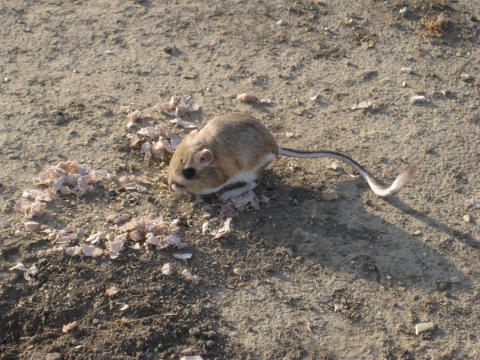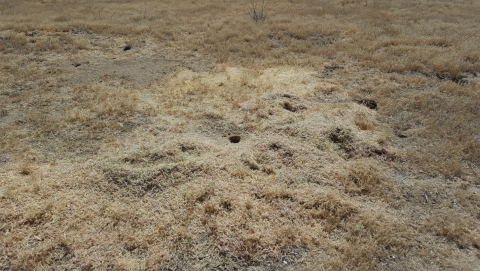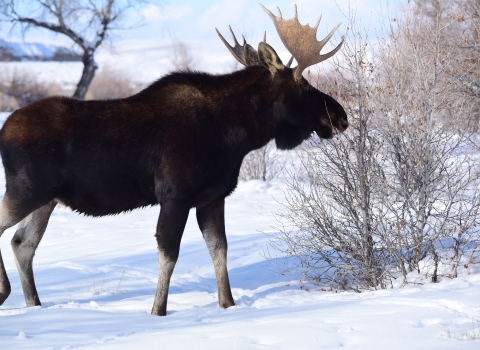With over 14,000 acres of habitat supporting hundreds of animal and plant species, there is no such thing as a "typical day" on Bitter Creek National Wildlife Refuge (Bitter Creek)—but some days stand out more than others. That was certainly the case on September 30, 2016 when a giant kangaroo rat was discovered in the north-western portion of the refuge.
"It's nice to get the documentation that it's on the refuge," said California State University (CSU), Stanislaus Research Technician Larry Saslaw.
He set the live trap that caught the giant kangaroo rat and thinks Bitter Creek can be the link connecting several neighboring areas that already serve as habitat to the species, thereby broadening its range.
This brief encounter with the elusive giant kangaroo rat did not happen by chance, it was the result of years of planning and a couple of strategic partnerships. Bitter Creek is part of the National Wildlife Refuge System—a network of lands and waters the U.S. government designated for conservation, management, and in some cases restoration of fish, wildlife, and plant resources and their habitats. So, it comes as no surprise that Bitter Creek staff have been working on conservation planning as part of the Hopper Mountain National Wildlife Refuge Complex (Hopper Mountain). In 2013, Hopper Mountain released a comprehensive conservation plan that called for grazing on the very portion of Bitter Creek where the giant kangaroo rat was found. The conservation plan also enabled the refuge to establish the Small Mammal Monitoring Project, allowing for adaptive management, as well as effective and efficient use of resources to support a healthy ecosystem.
Saslaw is part of CSU Stanislaus' Endangered Species Recovery Program. Bitter Creek established the partnership with the university three years ago to enhance the refuges' small mammal monitoring efforts. The Endangered Species Recovery Program helped Bitter Creek set up their monitoring program and is actively working with staff to build capacity.
According to U.S. Fish and Wildlife Service's (Service) Pacific Southwest Regional Director Paul Souza, "this collaboration demonstrates the power of conservation partnerships—which is a priority for the Service. Both of our programs are benefitting from the close coordination and our shared goal to ensure threatened and endangered species have suitable habitat where they can thrive."
The presence of giant kangaroo rats on the refuge—and other small mammals—is an indication of a healthy ecosystem. The north-western portion of the refuge borders the Carrizo Plain National Monument (managed by the Bureau of Land Management) and it is not uncommon for species from the Carrizo Plain to cross over into Bitter Creek. In fact, there are occasional sightings of San Joaquin kit fox and pronghorn (i.e., American antelope)—but the September capture of the giant kangaroo rat marks the first-ever sighting of the species on Bitter Creek.
"I think it's important because it demonstrates that our goals for Bitter Creek are achievable," said Project Leader for Hopper Mountain Refuge Complex, Michael Brady. The habitat enhancements target giant kangaroo rat and San Joaquin kit fox populations—providing an area outside the Carrizo Plain that offers suitable habitat. "We're very proud of the work that we've done since the conservation plan was completed and the partnerships we've developed. We're looking to do more for these species in the future."
Another critical partnership in this effort was with Eureka Livestock, LLC. Nick Etcheverry is a partner in the family-owned business, who has worked closely with Bitter Creek for the three years his organic natural/grass-fed SimAngus cattle have been grazing designated portions of the refuge. Both the San Joaquin kit fox and the giant kangaroo rat prefer grasslands with low vegetation. Bitter Creek has used grazing as a tool to create the ideal habitat for these species—which offers a win-win for Etcheverry and the endangered species.
"My dad and I were very excited when we heard about the sighting of the giant kangaroo rat on the fields what we had grazed last season. We know that all the work that the refuge has put in, the work that we put in, it actually paid off. We've been grazing on endangered species habitat for the last 40 years. We do care about it—it's not just all for us and the benefit of my cows. I want the elk and kit fox and kangaroo rat, I want everybody out there," said Etcheverry. "Working with Bitter Creek, we both have the same goals, we want to promote endangered species habitat along with good habitat where that more species of plants can grow."
Grazing promotes plant species diversity that will increase over time. According to Etcheverry, in the years to come, this diversity will be even more beneficial to his grazing cattle.
The giant kangaroo rat has been federally listed as endangered since 1987 and the Service released a recovery plan shortly after that summarizes a variety of recovery strategies for this species and 33 others in the San Joaquin Valley. The giant kangaroo rat has a diet that primarily includes seeds, but when compared to the other 20 species in its genus, it is the largest—with an adult weighing between 4.6 and 6.4 ounces and 12.2 to 13.7 inches long. It is mostly active between sunset and sunrise—spending non-foraging hours in complex burrows that can have five or more openings. It is the keystone species of the desert ecosystem. Its burrows serve as home to federally listed blunt-nosed leopard lizards and other species and it is prey for larger animals, such as the San Joaquin kit fox.
Brady seems confident that both the giant kangaroo rat and San Joaquin kit fox will either become regular visitors or make Bitter Creek their new home in the near future.





